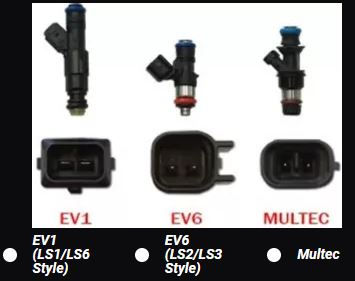Interchanging Parts with the LS engine series - What is possible?
- LS Harness Connection

- Aug 12, 2021
- 4 min read
Updated: Jan 21, 2022

What if I told you that the "LS Swap" doesn't always use an LS engine.... You might think I'm crazy for saying such a thing given my business name and staple, but it's true. The LS is actually a portion of the RPO designation, and shares physical and mechanical characteristics with that of the Vortec series of engines started in 1998, not to be confused with the TPI engines of the early to mid 90's.
The LS designation is for the series of Generation 3 and 4 (99-14) Chevrolet Small Blocks that were commonly used in car chassis (save the LS2 which was used in the SSR and TrailBlazer SS models). There are a few differences between the LS and Vortec like the front accessory drive being closer to the block to help combat tight spaces, the block itself being aluminum, and the intake manifold being flat and pressed against the valley of the engine when compared to a Vortec intake manifold. But of course, GM had their fun and made a few Vortec truck blocks aluminum as well with the move to the 4th generation engines.
The Vortec engine series was used in trucks and SUV's like the Silverado, Sierra, Tahoe, and Suburban, along with the Astro Van. These blocks are typically cast iron, so they are around 100lbs heavier, do not use the small style front-drive system, and have a noticeably taller (and less attractive in earlier years) intake manifold.
When ordering a harness from LS Harness Connection, it is important that you know as much about your engine, so I know as much about your engine, and you end up with the correct harness. If you have the donor vehicle information or the original harness that absolutely came from that same vehicle, you're ahead of the game. If not, no worries - keep reading and it we will get it all figured out!
24x or 58x -
Determining your Reluctor Wheel
There are a few different ways of determining what reluctor wheel you have, and it is one of the most critical pieces of information. Your crank reluctor wheel is what your crank signal sensor reads in order to control the electronic ignition portion of the LS swap. As you can tell from above, there are 2 options - 24x or 58x. 24x is used from the factory in almost all engines from 99-07, however, there are some 2006 engines that were 58x. The easiest way to do this on an engine that has been untouched is to look on the passenger side of the block toward the rear. The sensor located here is your crank sensor signal, and can quickly tell you what reluctor wheel you have. 24x uses a black-bodied sensor, and 58x uses a tan bodied sensor (see below). If you have the oil pan off or have a borescope to inspect through the crank sensor bore, you can compare the image of the wheel to the ones below. 24x will have more spaced out tabs, and will have half the number of the 58x.

Cable or Electronic Throttle?
If you're running Gen 3 (99-07) you can easily swap between cable and electronic throttle by swapping out the throttle components. If switching from cable to electronic, you MUST ensure that all components are from the same vehicle and that your PCM is programmed correctly for the change. Mismatched components can produce results like non-movement, reverse movement, flipping, and other issues.
Generation 4 (06-14) is a little more tricky with the factory ECM, and the required connections for cable throttle cannot be added to the factory engine computer. If you can run electronic throttle, it will be easier, but if you do not have the electronic throttle components, or still want to run cable throttle body, you may purchase a signal converter here to allow the conversion of your crank and cam signals to a 24x system, and use a Gen 3 computer for system control.

Fuel Injectors
GM used 3 different styles of injectors from the factory - because of this, you will need to determine more information than "factory injectors" when planning your harness build. Vortec (Truck platform) engines used Multec style injectors in many of the earlier models (99-03), but with the introduction to flex-fuel capabilities, they began using higher flow EV6 style injectors. The LS platform did not use the Multec style injectors, but instead, the LS1/LS6 used EV1 style, and LS2/LS3 used the EV6 style, similar to the newer style injectors used on the Vortec engines. If your head is spinning, the injector connectors are laid out below, or you can feel free to send me a photo of them for identification.

Mixing and Matching
GM did a great job of keeping many of its components replaceable between vehicles and engine platforms. Generally, LS1/LS6 components are able to be used on the Vortec line of engines without much issue or work needed. Swapping from the large truck intake to a slim LS style intake is a common practice, and is easily accomplished. With this, you will have a difference in fuel rails and throttle body height and placement, so you will need to account for this change. Also, because the car intake sits lower, you will have clearance issues between the throttle body and the water pump. Some remedy this by flipping the throttle body so it points upward, or there are a number of water pumps or spacing options available from vendors like ICT Billet or Dirty Dingo. Determining the correct mixing and matching of parts for your specific swap is best planned with the vendors of those products you are using to ensure the most correct information and fitment.








Comments